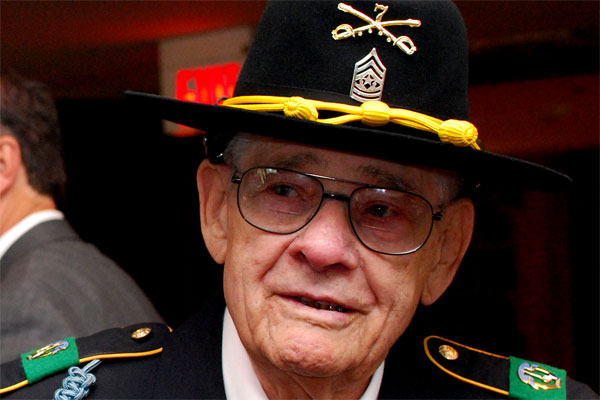Command Sergeant Major Basil Plumley will not have his military records amended by US Army officials. There are discrepancies in his records that call into question the medals that are a part of his legend.
Military researcher Brian Siddall has claimed that Plumley wore unauthorized combat and valor awards, exaggerating his achievements and raising his status among the airborne and infantry communities. This prompted the Army Human Resources Command to review Plumley’s records.
Plumley passed away on October 10th, 2012. He was 92.
He is known for his role in the 1992 book We Were Soldiers Once… and Young, by Joseph L. Galloway and Lt. Gen. Harold G. Moore.
The book tells of the November 1965 Battle of la Drang Valley during the Vietnam War. That fight pitted 450 soldiers from the 1st Battalion, 7th Cavalry against 2,000 North Vietnamese soldiers at LZ X-Ray.
The book and subsequent Hollywood movie made Plumley a celebrity long after he retired from the Army in 1974.
Siddall’s research into Plumley’s service in World War II with the 82nd Airborne Division led him to write two articles online in 2015 that demonstrated differences between Plumley’s service records and the awards for which he took credit.
Siddall obtained Plumley’s service records and says that Plumley claimed valor awards, combat infantry brigade stars, and combat jump stars that he did not earn.
Siddall requested that Plumley’s headstone in Fort Benning, Georgia, be changed, which led to the Army Human Resources Command review.
“Based on the facts available, U.S. Army Human Resources Command has determined there is no substantial evidence that any of CSM (R) Basil Plumley’s awards or decorations are in error,” wrote Lt. Col. Janet Herrick, a spokeswoman for HRC. “Absent this evidence, U.S. Army Human Resources Command is not authorized to alter or amend CSM (R) Plumley’s military records.”
Herrick did admit that there are discrepancies in Plumley’s records, but HRC is not authorized to change them. Siddall insists that Plumley misrepresented the number of Combat Infantry Badges he had been awarded. Plumley claimed a Combat Infantry Badge with two stars, representing three total awards – World War II, Korean War, and Vietnam War.
Siddall claims that, as an artillery scout, Plumley did not meet the requirements for the Combat Infantry Badge. Plumley did not serve in the Korean War, so the Vietnam War was the only combat area for which Plumley was eligible for the award.
Siddall also states that Plumley’s records show him serving in the 320th Glider Field Artillery Battalion as a scout, therefore he was a Gliderman and not a Paratrooper. The records also show Plumley in units that didn’t serve in the Korean War.
Siddall says that Plumley also wore valor awards that he did not earn. He wore a Silver Star with a bronze oak leaf cluster indicating a second Silver Star. But the documents that Siddall has show that Plumley was only authorized to wear one Silver Star and a Bronze Star with one oak leaf cluster, not two. The documents also show that Plumley was not allowed to wear the V device with his Bronze Star medals.
But Plumley’s headstone reads “Silver Star with OLC” and “BSM W/V 2nd OLC.”
